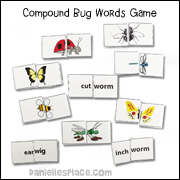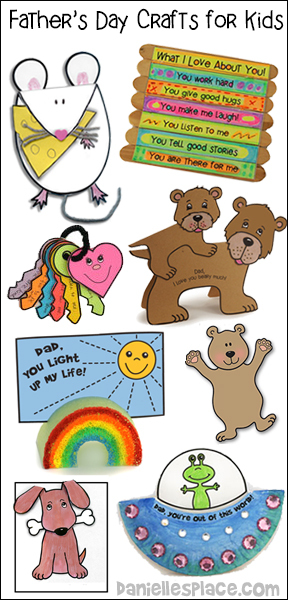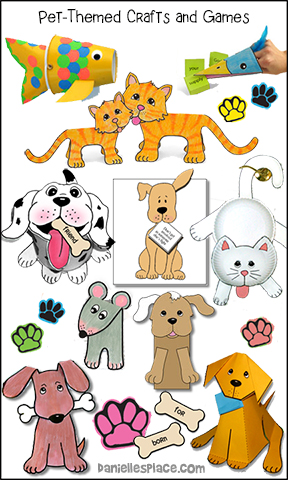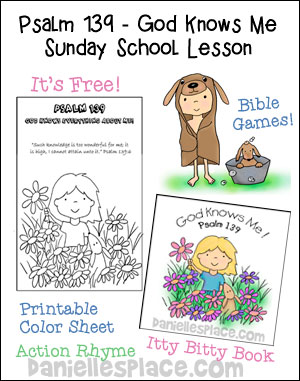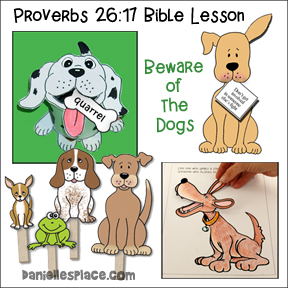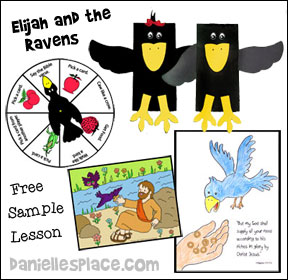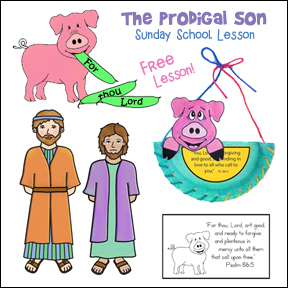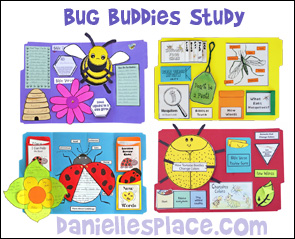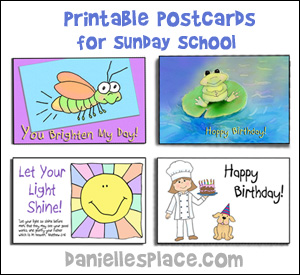Reading, Writing, and Spelling Crafts and Activities
Yummy and Yucky File Folder Reading Games
These adorable file folders can be used for many word review games. They are inexpensive and easy to make.
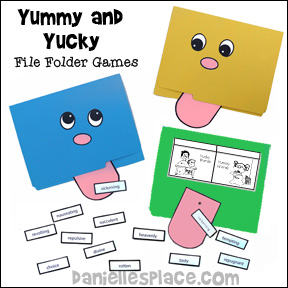
What you will need:
File Folders (Or Large Sheets 12" x 18" Construction Paper Folded in Half.)
Paper
Scissors
Card Stock
Glue or Tape
What to do:
1. Before class print out the eyes, nose, and tongue patterns. Or you can make your own patterns and use large wiggle eyes.
Instant Digital Download -  - Includes patterns for file folder and synonyms for yummy and yucky. - 5 pages
- Includes patterns for file folder and synonyms for yummy and yucky. - 5 pages
2. Attach the tongue to the inside, back of the file folder with a brass fastener. Place a piece of tape over the ends of the brass fastener on the back of the file folder.
3. Glue the eyes and nose to the front of the folder.
Word Review Games for Yucky and Yummy Folders
1. Synonyms for yucky and yummy vocabulary builder Print out the synonym sheets (or make up your own) onto card stock and cut them apart. Print out the pocket pattern, cut it out and fold it. Glue the pocket to the inside of the file folder as shown in the picture above. Help your child read the words and decide if they are synonyms for yummy or yucky.
2. Foods that are yummy and foods that are yucky - Write different foods on pieces of paper, both yummy and yucky. Have your children read the words and decide which pocket the words should go in. If you have more than one child, have them compare what they placed in the yucky and yummy pockets.
3. Things you lick and don't lick - Make list of things you can lick and never lick, write them on pieces of paper and have your children read them and place them in the appropriate pockets.
Lick - Popsicles, hard candy, thumb,stamps, envelopes, fingers, spoon, lips, Tootsie Pop, sucker, beaters
Don't lick - batteries, electrical things, a very cold popsicle or metal object,
Learn to Read Bookworm Pointers Craft
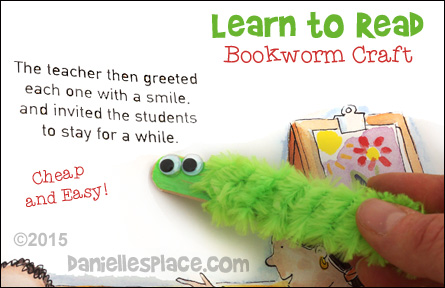
Children will become "bookworms" in no times with these adorable bookworm pointers! And they are so cheap and easy to make.
What you will need:
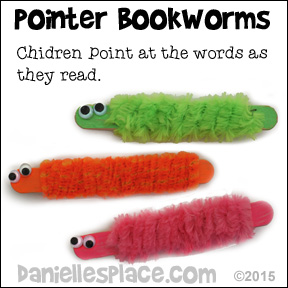
Chenille Stems - The Fuzzy ones work the best. If you use these, you will need only one stem per bookworm craft. The pink and green bookworm picture use 15mm Bright Multi Chenille Stems.
If you use the regular 6mm chenille stems, you will have to use about four of them for each bookworm (orange bookworm).
Paint Marker Pens - The colors are amazing and there is no messy clean up, Acrylic Paint, crayon, or markers.
7mm Wiggle Eyes - (If you want the eyes to stay on use a low temp. glue gun. Do this part for the child.)
How to Make the Bookworm Pointers:
1. Paint the crafts sticks with acrylic paint or liquid chalk markers. (Liquid chalk markers are water soluble so if you use these make sure the pointers don't get wet.)
2. Wind a Chenille stem or stems around the center of the craft stick leaving an open space at the top and bottom of the craft stick. Glue the ends of the stems to the craft stick so the stems don't unwind.
3. Glue wiggle eyes to one end of the craft stick.
4. Use the bookworms as pointers to help your child learn to read.
©2015, Digital by Design, Inc. - This is copyrighted, including any derivative work - See Copyright Regulations for this web site.
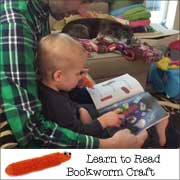
![]()
Check out a video on Youtube Logan's Life and see how these bookworms can be used with toddlers.
Word Wall Printables
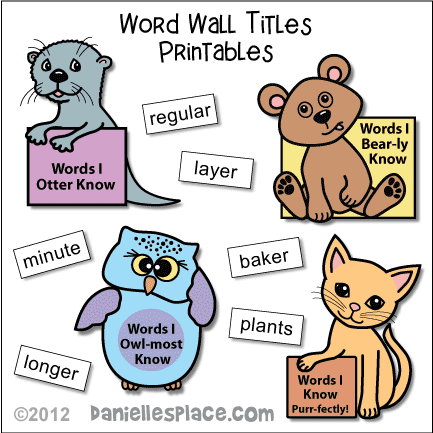
Use these charming printables to encourage your children to learn and spell or learn new words. Print out the patterns onto cardstock and staple them to a bulletin board. Make word cards by cutting different colors of construction paper in half lengthwise and then into two-inch strips.
You can also glue the pictures to the outside of a file folder and store the word cards in the pockets. Or glue them to a large envelope and store the words inside the envelope. Printables are available in two sizes: full-size page and half-pages.
"Words I Otter Know" Word Wall Title Printable
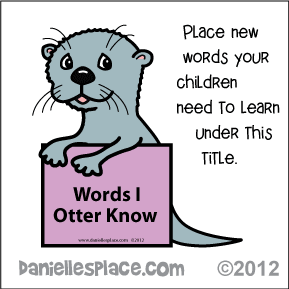
If your child is learning to read, print any new words he doesn't know on word cards. Pin the new words under the "Words I Otter Know" otter picture.
When your child is done reading, go over the new words, and then ask your child if he recognizes any of the words. If your child knows any of the words, let him take the word cards down and pin them under the "Words I Bear-ly Know".
If you are using spelling words, remove all the spelling words from the board and go over them a couple of times, and then have your child spell the words on his own. If he spells a word correctly the first time without any help, pin the word card under the "Words I Bear-ly Know" bear picture. If he doesn't spell the word correctly the first time, go over the word again, but pin it back under the otter picture.
The next day follow the same process with the word cards under this picture.
©2012, Digital by Design, Inc. - This activity and the word phrases are copyrighted, including any derivative work (A derivative work is a new, original product that includes aspects of a preexisting, already copyrighted work.) - See Copyright Regulations for this website.
"Words I Bear-ly Know" Word Wall Title Printable
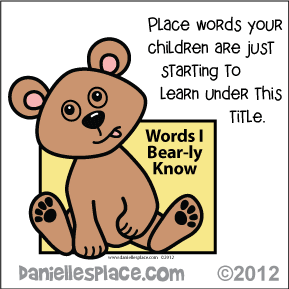
The words under this category are words your child has already studied or recognized correctly at least once. They should be reviewed every day until your child can spell or read them.
If you are practicing spelling, remove all the words that are pinned under the bear. Ask your child to spell the words. If he can spell the word on the first try, let him pin it under the "Words, I Owl-most Know" owl picture. If he can't spell a word, go over the word and then place it back under the "Words I Bear-ly Know" picture.
If you are practicing word recognition, leave the words under the bear picture and ask your child if he recognizes any of the words. If he can say any of the words the first time, let him take the words down and pin them under the "Words I Owl-most Know" owl picture. If he doesn't recognize a word, go over the word again, but leave it pinned under the "Words I Bear-ly Know" picture to be reviewed the next day.
"Words I Owl-most Know" Word Wall Title Printable
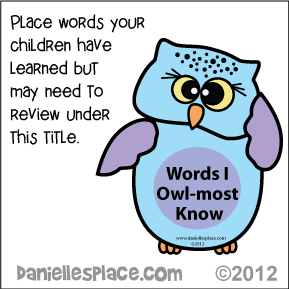
The words under this category are words your child has already recognized or spelled correctly at least twice. They should be reviewed every day until your child can spell or read them.
If you are practicing spelling, remove all the words that are pinned under the owl. Ask your child to spell the words. If he can spell the word on the first try, let him pin it under the "Words, I Know Purr-fectly" cat picture. If he can't spell a word, go over the word again and then place it back under the "Words I Owl-most Know" owl picture.
If you are practicing word recognition, ask your child if he recognizes any of the words under the owl picture. If he can say any of the words without help, let him take the words down and pin them under the "Words I Know Purr-fectly" cat picture. If he doesn't recognize a word, go over the word again, but leave the word pinned under the "Words I Owl-most Know" picture to be reviewed the next day.
"Words I Know Purr-fectly" Word Wall Title Printable
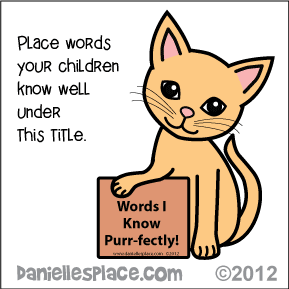
The words under this category are words your child has already recognized or spelled correctly at least three times. They should be reviewed at least every week until you know your child will not forget them. If you have a lot of words under this category, you can start taking the easier words off and only display recent words.
©2012, Digital by Design, Inc. -This activity and the word phrases are copyrighted, including any derivative work (A derivative work is a new, original product that includes aspects of a preexisting, already copyrighted work.) - See Copyright Regulations for this website.
Spelling Games
Spelling Dominoes
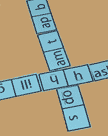
Play dominoes and review beginning and ending sounds. Beginning sounds used in this game are: b, fl, ch, h, s, sh t, w, g, it, an, op ar. Ending sounds used are: op, in, am, um ap ash, ill, en at, it, an, ch, and ar.
Turn all the dominoes cards over on the table. Each player picks seven cards. Place one card in the middle of the table. Take turns trying to match up the dominoes to spell out words. Some of the dominoes have the same letters or letter sounds on both sides of the dominoes. Use these dominoes to start new paths going in different directions. The "it", "an", "op" and "ar" dominoes can be used as either ending or beginning sounds. The first player to use up all his cards wins. If no one uses up all his cards, the player with the least amount of cards wins. If you can't play a card on your turn, you must pick up one card. You can try to play the card you picked up on that turn. When placing dominoes the letters must be able to match up so that they are both facing the same direction except when using the dominoes that are used to make new paths.
Words that can be used in this game:
bop, flop, chop, hop, top, bin, chin, sin, tin, gin, flam, ham, Sam, bum chum, hap, sap, tap, gap, flap, chap, hap, sap, tap, gap, bash, flash, hash, sash, gash, bill, chill, hill, sill, till, gill, ben, hen, ten, bat, flat, chat, hat, sat, tat, itch, its, ant, open, art, and arch.
©2004 - Digital by Design, Inc. - See Copyright Information
Duck, Duck, Goose Spelling Game
This game is played like "Duck, Duck, Goose" except children spell out a word. The child walks around the circle tapping a child's head for each letter of the word. On the last letter he runs around the circle while the child that was tapped last chases him. If the child spelled the word wrong, or if the child chasing him tagged him, he has to do it again.
What Letter is Missing?
Write a spelling word on pieces of paper one letter per paper. Place the letters in order and show your child the word. Tell him to close his eyes while you remove one letter. Mix up the papers. Now tell your child to put the letters back in order to spell out the word and then tell you which letter is missing. (You can use letters from a Scrabble game or letter blocks instead or cutting up pieces of paper.)
Play Hangman
Play Hangman except use only your child's spelling words. If you don't like the idea of a hangman, make up a different character.
Spelling Review with a Puppet
You will need a puppet that can open and close its mouth for this review game. Tell your child that the puppet is very hungry. Give your child some small sheets of paper and tell him that the paper is the puppet's food, but the puppet only likes to eat food that has words on it and only words that are spelled correctly. Give your child a spelling word and tell him to write it on the piece of paper and then try to feed it to the puppet. If the word is spelled correctly, make the puppet eat it up and make happy sounds. If the word is spelled incorrectly, make the puppet start to chew on it but then spit it out and choke on it. Tell your child that the puppet didn't like it because he didn't spell the word correctly. Let him try again until he spells it right.
Learn to Spell Helps
Learn American Sign Language and Spelling at the Same Time
This
is a great way to review spelling words. Teach your child the signs
for each of the letters. You can find information and printouts
for each letter on many web sites.
Once you both know the letters, you can take turns spelling words
to each other and seeing if you can guess what the other person
is spelling.
Make up your own sign language - This is a great way to review and get the wiggles out at the same time. Help your child come up with different ways he can make each letter of the alphabet using his whole body then give him a word to spell using his body.
Learn to Read Game
"What Can It Be?" Reading Game
This is a great way to review vocabulary words that your child is having trouble remembering.

What you will need:
Construction Paper
Pictures from Coloring Books
Magazines
Calendars
How to Make "What Can It Be" Reading Game:
Mark off lines one inch apart on a piece of construction paper as shown in the picture. Print one of your child's vocabulary words above each line. Cut on the lines leaving one inch from the side of the paper intact. Glue a picture on another piece of construction paper, any size will do, even a very small picture. Then staple the word page on top of the picture page. Staple the left-hand side that hasn't been cut so that you can lift up the word strips to see what is under them.
Ask your child to pick any word on the page and tell you what it says. If he can tell you what the word is, lift the flap to reveal part of the picture underneath. If he doesn't guess correctly, he should pick another word to read. Keep playing until he has discovered what the picture is.
©2000, Digital by Design - See Copyright Information
Feed The Dogs Reading Folder Game

This game can be used with children at all levels. Word endings are written on the dog bowls and beginning sounds are on pieces of dog food (square pieces of paper). Your child must place the dog food into the correct bowl to spell a word. Each dog must end up with only three pieces of food.
The patterns for this game are available to members only. (Just click on the link.) It includes six games with different word endings: at, it, og, ot, ig, ed, ut, in, an, ar, un, ap, ake, ace, ice, and oke.
©2000, Digital by Design - See Copyright Information
"Is It a Word?" Learn to Read Game

What you will need:
Card stock (Heavy Paper)
Lunch Bags
Scissors
Glue
What to do:
1. Before class print out the word cards onto card stock and cut them out.
2. Glue the title of the game, "Is it a Word?" on the bags as shown in the picture. Place the cards in the appropriate bags.
How to Play:
1. The first player selects one card from each bag and puts the letters together to see if they spell a word. If the letters spell a word, the player gets a point. The player then places the cards back in the bag and shakes it up again for the next player. The first player to reach ten points first wins.
©2000, Digital by Design - See Copyright Information
Flat Cat Learn to Read Game and Craft
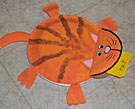
Use this cute little cat to play a word game that teaches your children words that rhyme with "cat". Children will love making their own flat cats to take home and help them learn to read.
What you will need: Two or three Styrofoam dinner plates or heavy duty paper plate for each cat, one small paper plate, acrylic paint, glue or staples, large paper clip, and sticky note paper or plain paper.
How to Make Flat Cat Learn to Read Game and Craft:
1. Cut out legs, ears, and a tail from one paper plate or a Styrofoam tray. I cut the feet from around the rim of the paper plate so that they naturally bend down. Try not to have the feet and tail stick out too far. This makes it harder to spin because the tail and legs keep bumping on things.
2. Glue or staple the legs and tail to the top of one plate.
3. Cover that paper plate with another paper plate to form the cat's body. The plates should be glued or stapled top to top.
4. Fold the small plate in half to form the cat's head. Glue ears to the head at the fold. Glue the head to the body.
5. Paint the cat.
6. Write words that rhyme cat such as rat, mat, sat, flat, fat, bat, hat, pat, rat, tat, at, and vat on sticky note paper or just small pieces of paper. Place the stack of words in the cat's mouth. Secure the words with a large paper clip or clothespin.
7. To play have the children sit in a circle around the cat. Take a hold of two of the cat's legs and spin the cat. (Practice this before class) The child that is in line with the cat's head picks a word card and reads it. Keep going until all the words have been read.
©2000, Digital by Design - See Copyright Information
Rainy Day Words Cloud Craft and Learning Activity
Children assemble the cloud and rainbow craft. They think of words that describe a rainy day and write them on the raindrops. They can then make a cloud shaped book and write a rainy day story using the new words they have learned.
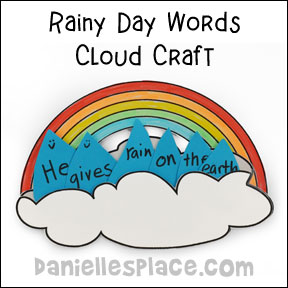
What you will need:
Paper
Crayons
Scissors
Glue
How to Make:
1. Print out the rainbow pattern and front cloud pattern and the back cloud. Have the children cut them out.
2. Color the rainbow.
3. Glue the small cloud to the bottom half of the large cloud matching up the sides and bottom. Glue around the edge to form an envelope.
4. Glue the rainbow to the back of the large cloud as pictured above.
5. Use the raindrop pattern to cut raindrops shapes from blue paper or just color the raindrops.
6. Have your children think of words that would describe a rainy day and write them on the raindrops and then place them in the cloud envelope.
7. Use the large cloud pattern to make a cloud shaped book. Write a story using the new words in the cloud shaped book.
©2004 - Digital by Design, Inc. - See Copyright Information
Label Mommy Game
Here's another fun activity to help your child learn to read.
What you will need: Sticky Note Papers, or Small Pieces of Paper and Tape and marker
How to Make Label Mommy Game:
1. Before you start tell your children that they need to pay attention really well because every word that they remember they will get to stick on you, but every word they forget, you get to stick on them.
2. Help your children think of words that are body parts such as eyes, ear, nose, forehead, cheek, hand, feet, chin, lip, mouth, etc. Go over each word and write them on a separate piece of paper.
3. Mix up the words and set them out on the table. Have your children take turns picking a word and trying to figure out what it is. If a child figures out what they word is he picked, he can stick it on the body part that is written on the paper. If not, you get to stick it on him.
©2000, Digital by Design - See Copyright Information
Twister Review Game
This is a great way to teach children who can't sit still for very long. Use a dry erase marker to write numbers, letters, or vocabulary words on the circles. Write the same numbers, letters, or words on the spinner. Play just like twister except call out the words instead of the colors.
Frog Learn to Read Game - Musical Lily Pads
Cut out lily pad shapes from construction paper. Write your children's vocabulary words on the lily pads, one per lily pad. Tape them to the floor in a circle just far enough apart so that your children have to leap to reach the next lily pad. Play like musical chair except no one has to sit down. As you play some music have the children leap from one lily pad to the next. When the music stops each child reads the word on his lily pad.
Free Feed the Kitty Word Sounds Game
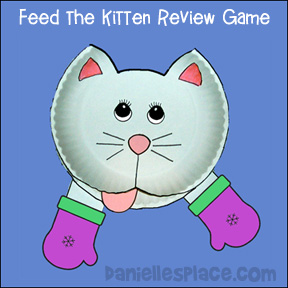
This cute little kitty will help your child learn to read in a fun and active way.
What you will need:
Two paper plates
Card Stock
Glue
Scissors
How to Make Feed the Kitty Word Sounds Game:
1. Print out the patterns for the Eyes, Nose, Arms, and Tongue Pattern and cut them out. Color the nose and tongue pink.
2. Print out the Cat Face Pattern and use it as a template to cut a paper plate to make the cats face. Use the the pattern to cut just the ear shapes out of another paper plate for the back of the head. Glue the two paper plates together (top to top) to make the face.
3. Glue on the nose and eyes. Draw in the whiskers with a black marker. Color in the ears. Glue the arms on the back of the head as shown in the picture.
4. Cut a slit in the paper plate used for the back of the head 2 1/2" long and 1/4" wide. Slip the tongue down through the hole so that it stick out of the mouth.
The Kitty can be used to teach and review many subjects.
©2000, Digital by Design - See Copyright Information
Review Letter Sounds - Print out small pictures of different items and place a piece of tape on the back of each one. Using pictures from your child's worksheets works great. Tell your child that the kitty is very hungry but she only wants to eat things that start with the "a" sound. (Move the kitty's tongue back and forth.) Ask your child if he or she can find a picture of something that starts with that sound and place it on the kitty's tongue. If the child is correct, the kitty will eat it. (Pull up the tongue so it looks like the kitty is eating it. And pull it all the way out and remove the picture. Then place the tongue back in it's mouth. If the child picked a picture that does not match that letter sound, just move the tongue back and forth and tell your child that the kitty does not like that one because it doesn't start with that sound, and he should try again. (You can also play this game using ending sounds and long or short vowel sounds.)
Review words - Play as above only use word cards with matching pictures. Show your child a word card and have him feed the kitty a picture that matches the word.
Review Numbers or Letters - Give your child a pad of small sticky notes. Tell him that the kitty is hungry for a certain letter or number. He should write the letter or number on the sticky note and feed it to the kitty. If he is correct, the kitty eats it. If not, he must try again.
Spelling Words - Play as above only have your child write his or her spelling words on sticky notes. If he or she spells them correctly, the kitty will eat them, if not, he must try again.
Learn to Read Helps
Reading with a Puppet
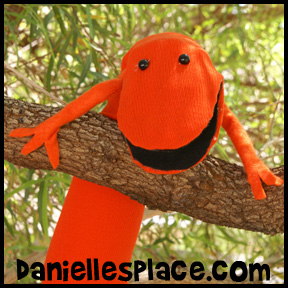
Is your child having a hard time sitting still and concentrating when you are teaching him to read? Here is a great technique to use that will take a lot of the frustration out process.
Children love to feel like they are in control and this technique will give them a little control. When you are having a hard time getting your child settled down enough to read bring out a puppet that says he knows how to read. Make the puppet sound like he is bragging.
Say something like, "I can read 100 words a minute! I can read the whole dictionary. Do you want to hear me read?" Of course your child would prefer the puppet to read than himself even if the puppet is better than him.
Once the puppet starts to read, have him get stuck on some easy words or say the wrong words and read the sentences so they don't make sense. Your child will then try to help him. If he doesn't volunteer his help, have the puppet ask him for help. The puppet can then say, "Wow, you're a pretty good reader!" This will give your child confidence in his reading. When my child was trying to help the puppet read and didn't know a word, she would whisper to me and ask what the word was and then tell the puppet. It was a lot of fun and she was reading!
Spelling and Vocabulary Word Games
Match Game
Use the word cards to play match game. Write your child's vocabulary words on index cards. Make two cards for each word. Place all the cards face down on a table. Take turns turning over two cards at a time trying to find matching cards. If they match, the player gets to keep the cards and try again until he misses. The player that has the most cards at the end of the game wins.
What's the Word?
Write all your child's spelling words or vocabulary words on index cards. Show your child a card and ask him what the word is. If e knows the word, he gets a penny or other reward. (If you are using spelling words, ask him to spell the word without showing him the card). If he knows the word or can spell it, take it out of the cards in your hand and place it on the table face up. If he doesn't know the word or can't spell it, tell him what it is or how to spell it and then place it in the back of the cards in your hand. Keep playing until all the cards are on the table.
Timed Review
Use a certain amount of cards and time your child to see how fast they can say all the words. See if they can beat their time.
Find the Special Card Vocabulary Review Game
Place a sticker on the back of one of the word cards. Place all the word cards on the table face up. Have your child select a card and tell you what it says. If she says the word correctly, she gets to turn it over to see if there is a sticker on it. If she doesn't know the word, help her pronounce it and then let her turn over the card to see if there is a sticker on it. Keep playing until your child finds the card with the sticker. You can give her a small reward for finding the card with the sticker. Place the sticker on another card and play again. Keep playing until your child gets bored.
Find the Missing Part Vocabulary or Spelling Review
Write your child's spelling or vocabulary words on index cards; but write half of each word on one card and the other half on another card. Write the first half of the words on yellow cards and the second half of the words on green cards so that your child knows to match up the cards with a yellow first and then a green. Spread the cards out on a table face up. Ask your child to match up the cards to make words. You can time her the first time and then have her do it again to try to beat her first time. Keep playing until your child can match up all the cards quickly.
Find a Word
You will need old children's magazines. Open up two magazines to pages with about the same amount of words on them. Take turns picking a word to look for. Each person looks for that word on their page and circles all the ones they find. The person who finds the most on their page wins.
Word Search
Make your own spelling word search - At Discoveryschool.com web site you can type in your child's spelling words and make a personalized word search.
Find Letter Blends, or Endings
Pick a common word blend such as tr, pr, th etc. Tell your child that every time she finds that blend in the book she is reading she will get a reward. Or if she can find a certain number of words with that word blend she will get a prize. This is a great way to help them learn how to spell.
Reading Crafts and Activities
Friday Fun Day Treasure Hunt
Treasure hunts are a great way to reinforce reading, math, and thinking skills. Your child will be motivated to read and figure out problems because he will be anxious to find the treasure at the end of his hunt.
You can design your treasure hunt to match your child's skills. In our home school, Fridays are fun days. We play review games and take field trips relating to what we are studying, etc. Treasure hunts are great because you can review all the materials you have covered that week.
Writing Games
Play "Don't Complete the Sentence"
Players take turns writing a word and adding to the previous words to make a sentence. The player who completes the sentence looses. Each player must have a sentence in mind when he adds his word. If a player can't think of a word to add to the sentence, the other player must finish the sentence. If he can finish the sentence, he wins. Younger children will like this game if you just write silly sentences and don't worry about who finishes the sentence.
Write a Silly Story
Each person takes a turn adding one sentence to the story until it is finished.
Writing Activities
Action Verbs Coloring Sheet
Action verbs are words that tell us what a person or thing can do.

©2012, Digital by Design - See Copyright Information
Adjective Art and Creative Writing Project
A Is for Angry: An Animal and Adjective Alphabet

This adorable book is more than just your typical ABC book! It uses adjectives and nouns to introduce children to the alphabet. But it can also be used for older children to teach adjectives and descriptive writing.
After reading the book assign each student a letter of the alphabet. Have them follow the same format as the book using adjectives with the same first letter to describe a noun. After they have illustrated their pages, bind them together to make a class book.
Write it Down!
Do you have problems getting your child to concentrate on his schoolwork? Does he keep coming up with questions and changing the subject? Here's a solution that will keep him focused or at least help him with his spelling and writing. Make it a rule that during school your child cannot ask a question that doesn't pertain to his lesson or change the subject unless he writes the question down so you can read it. For example, he might write, "Can I have a snack?" You would answer him by writing something such as, "You can have a snack when you finish your math." When he is finished he might write, "Can I have a snack now?" You can then write, "What would you like for a snack?" Make the words appropriate for your child's reading level.
If your child has a question that doesn't pertain to the lesson, such as "How do they make pencils?" Have your child write it down and tell him that we will set this question aside until we are done with the lesson and then we will try to find the answer. This will work great with children with ADD because they can then get their attention back to the lesson knowing that their question will be answered later.
This also works great when you are on the telephone. Your child won't have to interrupt you and he won't forget the question because it is written down. Don't worry about his spelling when you are doing this activity. Just keep track of the words he is misspelling and add them to his spelling list.
Reading and Writing Activities on Other Pages
Reading is Out of This World Paper Plate Craft
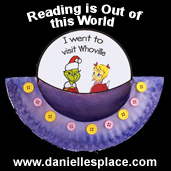
Use this simple paper plate craft to encourage your children to read. They will discover the limitless worlds they can visit through books and enjoy sharing those worlds with their classmates.
Go the the Outer Space Crafts and Learning Activities Page for more information about this activity.
Preposition Review Easter Egg Hunt and Writing Activity Bulletin Board Display
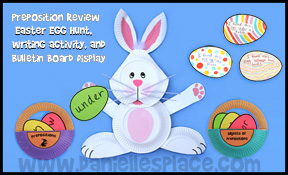
Use this Easter display to review prepositions, vocabulary words, or for other learning activities.
Go to the Easter Crafts and Learning Activities Page for directions and patterns.
Compound Words Scrambled Eggs Game
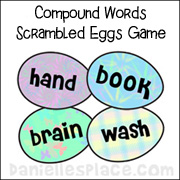
Children unscramble the Eggs to Make Compound Words!
This is a fun and challenging game that reinforces the fact that two words put together can make completely new words.
Go to the Easter Crafts and Learning Activities Page for directions and patterns.

Children scramble to collect the most eggs.
Go to the Easter Crafts and Learning Activities Page for directions and patterns.
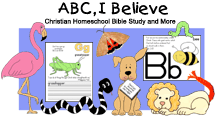
Start your home school day right with this fun and engaging Bible study curriculum for preschool through third grade.
To find out more about the ABC, I Believe Lessons AND receive the first four lessons for free go to the Home School Page for more information.


